What Does A Day in the Life of an Art Teacher Look Like?
7 min read [ad_1]
From the outside, a day in the life of an art teacher is filled with fun craft projects, from glitter and glue sticks to rainbow colors and resists. The tropes dictate that we are the multiple bag carrying, wacky, fun-loving, disorganized artmakers students come to for a “break” from their academic day. But is that the whole truth?
Insiders know we are often responsible for teaching record numbers of students per day, navigating multiple grade levels–all with one prep period. Classroom and art supply management are essential components of our practice, along with getting in the mindset to tackle long, energetic days with humor and grace. We also support daily school functions like every other teacher, including IEP and 504 meetings, lunch and break duty, club commitments, and student advisories.
So, what does is it really look like to live a day in the life of an art teacher?
Before we dive into what my day looks like, AOEU has a new series on YouTube called A Day in the Life (DITL) of an Art Teacher. Each episode gives a fun, sneak peek into the lives of art teachers across the country with tons of tips and tricks along the way. We often learn the most from each other by just observing!
Make sure you subscribe and turn on your notifications, so you don’t miss future episodes. If you would like to contribute by sharing a day in your life as an art teacher, we would love for you to apply here!
Rise and Shine
It’s 5:10 in the morning when I awake to the sound of chimes gently increasing in volume. I fumble to turn off the alarm and welcome a new day. Like many teachers, I’m up before the sun rises, trying my best to creep around the house as I go about my routine. Teachers cherish these quiet moments because so much of our day we have to be “on.”
By 5:30, I’m in the shower, listening to the news on my phone and thinking about anything I might need to grab from the house before I leave. Multitasking helps me create a mental list and center my thoughts before entering middle school’s hectic and noisy world.

Packing a full meal, plenty of beverages, and nutritious snacks to have throughout my day sets me up for success. Don’t rush through this part—no one needs a hangry art teacher! My family members and I scramble to get out the door. All this before 7:00 am.
Daily Rituals
During my forty-minute commute, I slowly sip my coffee and run through the steps I’ll take to support a successful day. Arriving at school early gives me the opportunity to set the tone.
Here are some of the classroom tasks that make up my daily morning ritual:
- I flip on only one set of overhead fluorescent lights. They are a known trigger for anxiety and migraines, so I try to use as few as possible.
- I set the mood by turning on two warm accent lights, string lights, the HEPA air filter, and two oil diffusers with class-approved scents (cinnamon and orange are favorites right now).
Note: Always consult with your district before using essential oils in the classroom. - I stream a lofi beats or Morning Chill station using a Bluetooth speaker at a coffee shop volume. It brings energy into the room without feeling invasive or distracting.
Focus By Eliminating
The first thirty minutes is “me” time. I’m not strict about the way I use this time since I enjoy having the flexibility to meet the needs of any particular morning. In general, this means eliminating the minor tasks that have a major impact. This allows me to be free and focused the rest of the day.
Here are some of the activities I do during my “me” time:
- I eat breakfast if I haven’t already.
- I open my planner and look at the week. I fill in what I know and focus on the most immediate priorities.
- I browse for a daily mindfulness quote to write on the board. I carefully curate these mindfulness meditation posts for my students by thinking about what might be affecting them and what has come up in school or class lately. Favorite sites include StarCodes (SEL-focused), Calm (check out their free educator account), and Affirmations and Quotes.
- I respond to any time-sensitive emails.
- I write out the week’s schedule on the board to support my students’ executive functioning.
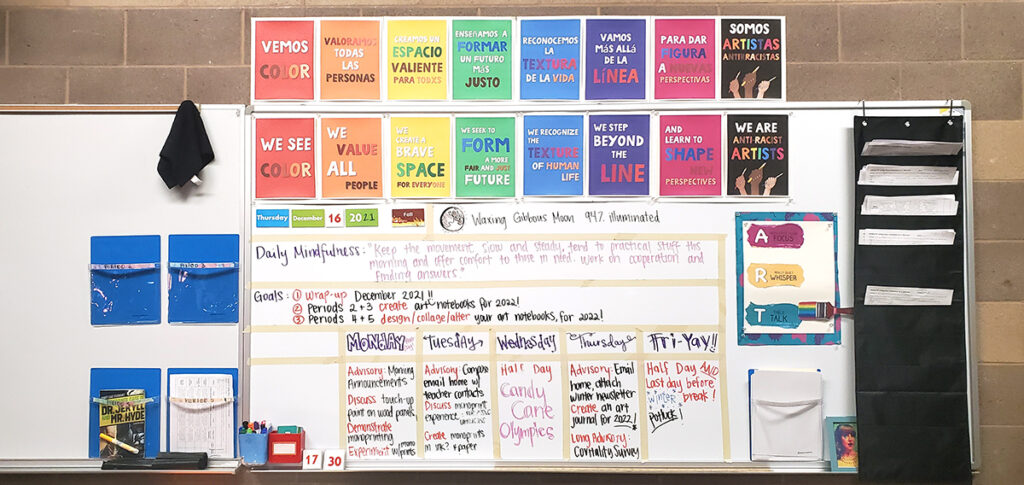
Meetings and More Meetings
My school holds all staff meetings before students start their day in the morning. Each day from 8:00 to 8:45 am rotates between team meetings, content area meetings, staff meetings, and grade-level meetings. As an art teacher who collaborates with multiple teams regularly, this meeting schedule provides time to check in with a wide range of colleagues.
Our first interaction with students is with a fifteen-minute Advisory. This is a non-traditional, mixed grade level class where we work on executive functioning skills, learn about current events, and focus on connecting. Each teacher works with a class of students that will be theirs for the students’ entire careers at the school. This has helped me connect with my students’ families and understand the school demographic.
Prep Period
After Advisory, we officially begin class periods. I have first-period planning. It starts the day off on the right foot! Since I have to leave work in a hurry to start my commute home in the afternoons, period one prep is a game-changer for ensuring a well-prepared classroom for the day ahead.
Instruction: Energy and Flow
I have about twenty-eight students in each of my fifty-minute art classes. In consideration of the 150+ students who circulate the art room daily, I take to heart the job of curating our space. By making deliberate choices and modifying my space throughout the day, I work to provide my students with the most inviting and efficient art classroom environment possible. Playful Learning, a website for parents and teachers, explains that “Children take cues from the environment and the way space is arranged can have a significant impact on their learning experience.”
I’m mindful about how and where my students access their materials. We have a stationary materials table with the daily essentials (pencil sharpener, paper, erasers, paper clips, scissors, rulers, etc). We also have a supply area on a long countertop where I set out specialized art items needed for the project at hand.
I consider whether students may benefit from a flexible seating arrangement each hour. I try to allow students the opportunity to spread out, which includes working in spaces outside the classroom, our two “soft” seating areas, or at a long countertop with outlets that are best for work that requires more focused attention.
As the morning moves into the afternoon, teams and projects change. I update the music, materials, seating options, and desk spacing to accommodate the new energy students bring.
Fifty minutes per period may seem like a long time, but it flies! Once I account for setup and cleanup, I am left with forty minutes to be students’ number one hype person, trying to maximize our time together.

Lunch Break
With a short twenty-five-minute lunch break, I have learned that it’s vital to ensure my students are well versed in the cleanup procedures. This way I am not stuck doing it and missing my chance to eat! My day can easily take a turn for the worse if I’m running on fumes. As we all know, lunch often gets taken up by students who wander in. We also have been known to spend our lunch stepping outside to get fresh air, tracking down an administrator to check on an issue, or running to the bathroom.
Literacy
We have a program called KBAR or “Kick Back and Read.” This time of day supports and encourages our students’ daily reading and literacy habits, along with targeted small group interventions as needed. As part of this initiative, I host four different groups of students in my room each week. I value the emphasis it places on reading and literacy school-wide. Even though we are art teachers, we are still responsible team players. It is important that we do our part to make sure school programs are successful.
Extra-Curriculars
The final period of our day is for our electives that meet twice per week. This may be similar to extra-curricular activities or clubs in your school. Our electives are mostly teacher selected and can be anything under the sun that is educational and has enough student interest. I have taught Digital Photography in Nature, Ceramics: Handbuilding and Wheel-Throwing, and a Rejuvenation and Gift Making Workshop. These electives have proven to be a delightful time! They are student-led, filled with new techniques and ideas, specific supports, and are pressure-free.
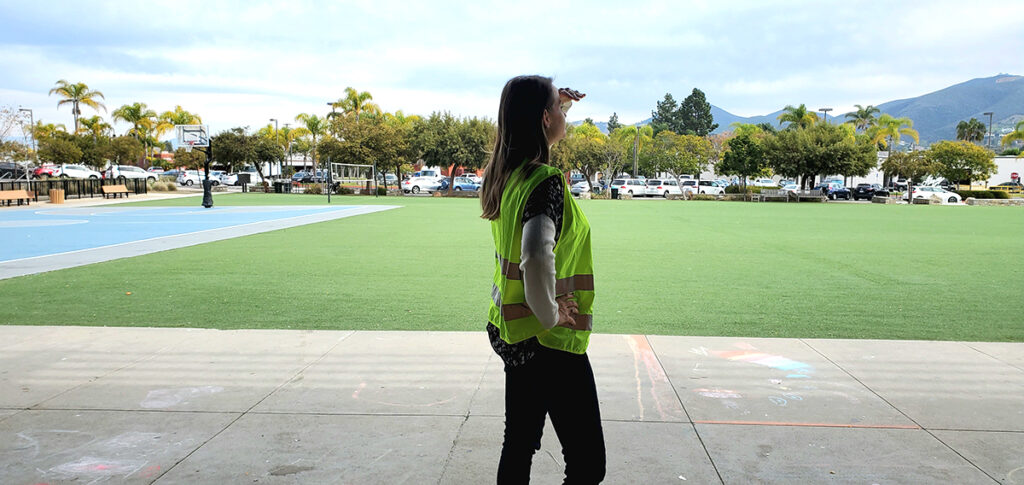
Between my 5:10 wake up to my 3:15 school ending time, I have completed a 10 hour day! I use my commute home to recharge my batteries, listen to podcasts, make appointments, or indulge in some quiet before the chaos of home life starts. While we do enjoy the rainbow-colored-glitter-and-glue sticks parts of being an art teacher, there are many fulfilling and challenging factors. A day in the life of this art teacher is dedicated to the invisible parts of teaching— strategically thinking and planning through the day and beyond, arranging the space, organizing supplies, and communicating to and between all of our stakeholders. Although our paint-splattered hands are constantly balancing the administrative teacher and studio artist duties, we wouldn’t have it any other way.
How did you imagine an art teacher spends their day before you started teaching?
What is the most surprising responsibility art teachers take on?
[ad_2]
Source link






